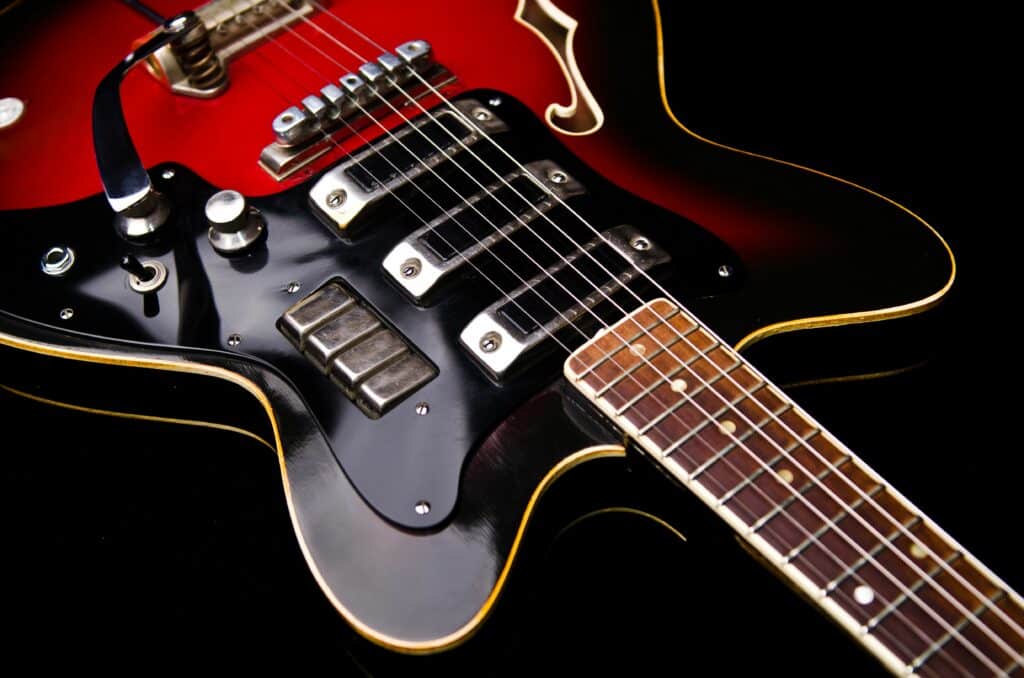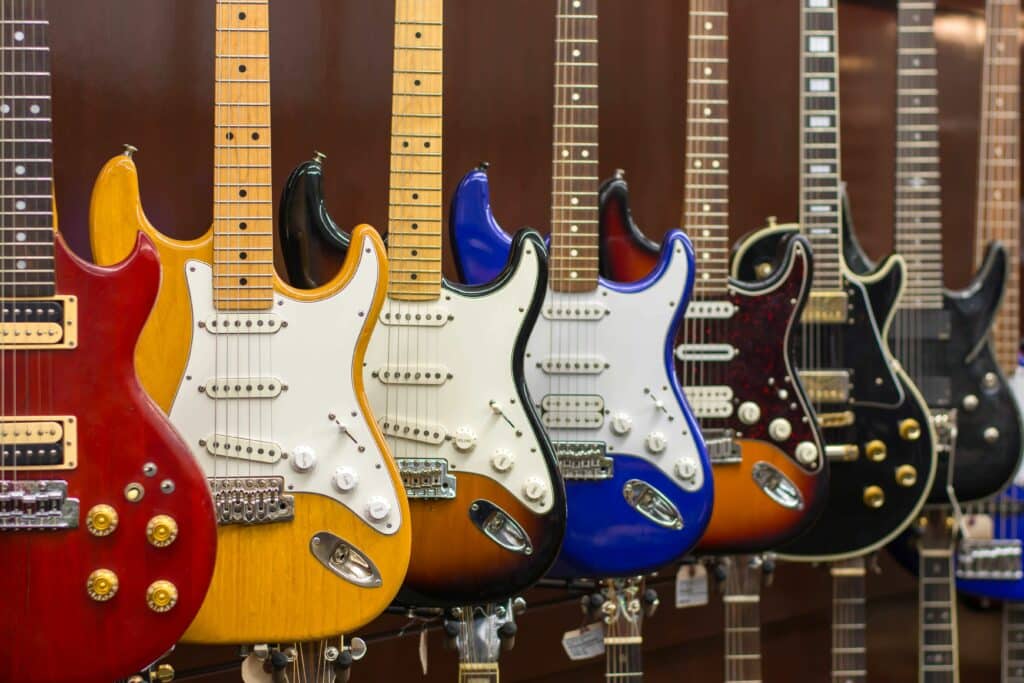
From face-melting solos to ear-bending effects, these revolutionary guitar techniques have left an indelible mark on popular music genres. You won’t believe how these 7 mind-blowing guitar techniques changed music forever!
The power chord and its role in the birth of punk and heavy metal

Power chords are the foundation of heavy metal music and have played an essential role in shaping the genre’s unique sound.
While it has roots in rock and roll and blues, power chords have changed and grown over the years to become an important part of heavy metal’s sound. With their strong, aggressive tone and driving beat, power chords have shaped some of heavy metal’s most renowned songs and albums.
Power chords are resilient, even though they only have a root and a fifth. Since they don’t have a third, they take on no significance, so they can fit in with many different musical styles and progressions, like rock, punk, and metal.
The use of feedback and distortion in shaping the sound of grunge

Feedback and distortion were crucial elements in shaping the raw, aggressive sound of grunge, a genre that emerged in the late ’80s and early ’90s.
Guitarists like Kurt Cobain of Nirvana and Jerry Cantrell of Alice in Chains embraced the noisy, abrasive qualities of these effects, using them to create a sense of chaos and intensity that perfectly captured the angst and disillusionment of the era.
By cranking their amps and letting their guitars’ feedback, grunge musicians produced a thick, sludgy tone that was both powerful and emotionally charged, setting them apart from the more polished, commercially oriented rock of the previous decade.
The use of feedback and distortion in grunge not only defined the genre’s signature sound but also influenced countless alternative and indie rock bands in the years that followed.
The finger-tapping technique and its influence on '80s rock and metal

The finger-tapping technique revolutionized rock and metal in the 1980s, enabling guitarists to create intricate, lightning-fast melodies and solos. This innovative method involves using both hands to tap the fretboard, essentially turning the guitar neck into a keyboard.
Pioneered by virtuosos like Eddie Van Halen and Stanley Jordan, finger-tapping allowed musicians to explore new sonic territories and push the boundaries of what was thought possible on the instrument. From Van Halen’s groundbreaking “Eruption” solo to the intricate work of players like Joe Satriani and Steve Vai, finger-tapping left an indelible mark on the decade’s musical landscape.
The technique quickly became a staple in the arsenals of ’80s rock and metal guitarists, who incorporated it into their flashy, high-energy performances. Its impact endures as contemporary guitarists refine and expand on the technique, keeping the essence of ’80s rock and metal alive through their thrilling performances.
The slide guitar and its importance in blues and country music

The slide guitar is an essential tool in blues and country music. It allows musicians to create haunting, emotive sounds that evoke the genre’s roots.
By using a slide, typically a glass or metal tube worn on the finger, guitarists can glide across the strings, producing smooth, fluid notes that mimic the human voice. This technique is particularly effective in conveying the raw, heartfelt emotions that are central to blues music, from the sorrowful wails of a lost love to the joyous exclamations of a wild night on the town.
In country music, the slide guitar adds a touch of twang and grit to the genre’s signature sound, complementing the storytelling lyrics and foot-tapping rhythms. From the early days of Delta blues to the modern country-rock scene, the slide guitar continues to be a beloved and indispensable part of these musical traditions.
The use of alternate tunings in creating the distinctive sound of '90s alternative rock

Alternate tunings played a significant role in shaping the distinctive sound of ’90s alternative rock, allowing guitarists to explore new sonic textures and create a sense of atmospheric depth.
By deviating from the standard tuning (EADGBE), musicians could craft unique chord voicings and melodic patterns that set their music apart from the more traditional sounds of the past.
Bands like Soundgarden, Pearl Jam, and Alice in Chains frequently employed alternate tunings to achieve their signature heavy, brooding tones. In contrast, others like Radiohead and Smashing Pumpkins used them to create ethereal, dreamlike soundscapes.
The use of alternate tunings in ’90s alternative rock not only contributed to the genre’s innovative spirit but also inspired countless guitarists to experiment with their creative tunings, pushing the boundaries of what could be achieved with the instrument.
The wah-wah pedal and its impact on psychedelic and funk music

The wah-wah pedal has been a defining force in psychedelic and funk music, adding a dynamic, expressive element to the guitarist’s toolkit.
By rocking the pedal back and forth, musicians can create a distinctive “wah” sound that mimics the human voice, allowing them to “speak” through their instrument.
In the psychedelic rock of the late ’60s and early ’70s, guitarists like Jimi Hendrix and Eric Clapton used the wah-wah to create trippy, mind-bending solos.
In funk music, players like Curtis Mayfield and Bootsy Collins employed it to add a percussive, rhythmic quality to their playing, perfectly complementing the genre’s tight, syncopated grooves.
The delay effect and its role in shaping the atmospheric sound of post-rock

The delay effect has been instrumental in shaping the atmospheric, ethereal sound of post-rock, allowing guitarists to create lush, textured soundscapes that envelop the listener.
The delay effect adds depth and dimensionality to the music by repeating and layering notes and chords, creating a sense of space and immersion that is central to the genre’s aesthetic.
Bands like Mogwai, Sigur Rós, and Explosions in the Sky have heavily relied on the delay effect to craft their signature sound, using it to build slowly evolving, emotionally charged compositions that often eschew traditional song structures in favor of more experimental, freeform approaches.
ELECTRIC GUITAR TO GET YOU STARTED
10S GF Old Blackie Heavy Relic

PERFECT FOR: Pros & Beginners
FEATURES: It has a sleek and well-oiled ebony fingerboard to make it flexible.
OTHER INFO: There's a headstock volute to provide flexibility to the neck structure.
10S GF Old Blackie Heavy Relic
- The well-connected strings offer maximum comfort to the user.
- The design, Mother of Pearl inlay, makes the product spectacular.
- The product doesn't bear a lifetime warranty.
When you click ‘Check Price’, you’ll see there are loads of great places to buy this item. Our personal favorite is Sweetwater for the US, and Thomann and Gear4Music for the UK & Europe.
They are the largest music retailers, with excellent customer service, competitive prices, really fast shipping, and the longest guarantees.
The professional musician who wrote this article combined many things,
from the product build, manufacturer’s reputation through to feedback
from other users, to create our famous TedScore™.
ESP Guitars KH-602

PERFECT FOR: Beginners
FEATURES: It has neck-thru-body construction and provides a sweet sustain. Beginners like the smooth feel from the top to the strap button.
OTHER INFO: The musical instrument bears a Floyd Rose bridge and EMG 60/81 pickup, making it quite different from other guitars.
ESP Guitars KH-602
- The body offers an excellent feel to the user.
- Good pickup makes the device quite comfortable.
- The advanced specifications provide the right tone.
- It possesses solid electronics, which marks durability.
- Minor white or silver flakes in the paint cause ripples.
When you click ‘Check Price’, you’ll see there are loads of great places to buy this item. Our personal favorite is Sweetwater for the US, and Thomann and Gear4Music for the UK & Europe.
They are the largest music retailers, with excellent customer service, competitive prices, really fast shipping, and the longest guarantees.
The professional musician who wrote this article combined many things,
from the product build, manufacturer’s reputation through to feedback
from other users, to create our famous TedScore™.
Squier Bullet Mustang HH, Black

FEATURES: Scale Length: 24"
OTHER INFO: Fretboard: Laurel
- Great value for its price.
- Comfortable design
- Two humbucking pickups for various genres.
- Easier playability, especially for beginners.
- Iconic association with musicians like Kurt Cobain.
- May feel too small for some players
- Suited for distorted tones, not ideal for pristine sound.
When you click ‘Check Price’, you’ll see there are loads of great places to buy this item. Our personal favorite is Sweetwater for the US, and Thomann and Gear4Music for the UK & Europe.
They are the largest music retailers, with excellent customer service, competitive prices, really fast shipping, and the longest guarantees.
The professional musician who wrote this article combined many things,
from the product build, manufacturer’s reputation through to feedback
from other users, to create our famous TedScore™.
Guitar Techniques:
Endless Evolution

From the finger-tapping virtuosity of ’80s rock and metal to the wah-wah-infused psychedelia of the ’60s and ’70s, the guitar has been a driving force behind some of the most transformative moments in popular music history.
Through the innovative use of effects, alternate tunings, and unconventional playing techniques, guitarists have continually pushed the boundaries of what is possible with the instrument, shaping the sound and style of entire genres in the process.
As music continues to evolve and new genres emerge, the guitar will remain a vital tool for creative expression. Each new generation of players will build upon the groundbreaking work of their predecessors to create something entirely their own.












all these new effects and techniques are just noise. music was better when it was just a guitar, a bass, and real skills. don’t need all that fancy stuff to make good music. seems like Lewis Turner is forgetting what made rock great in the first place.
The segment regarding the revolutionary impact of the finger-tapping technique in the ’80s brought back a lot of memories. It’s incredible to consider how much it changed the guitar playing landscape, empowering players to explore melodies and harmonies that were previously considered impractical or impossible. This technique has not only enriched the musical repertoire available to artists but has also significantly influenced guitar design and technology. The skill, creativity, and innovation embodied in this playing style are truly remarkable.
wat guitar would u recommend for someone just starting but wants to play like the 90s alt rock sound? any suggestions?
Hey, for that 90s alternative sound, you can’t go wrong with a Fender Stratocaster or a Telecaster. They’re versatile and were used by many bands back then. Alternative tunings play a big part in getting that distinct sound, so be sure to experiment!
Really enjoyed the piece on the slide guitar’s significance in blues and country music. It’s fascinating how such a simple technique, when mastered, can produce incredibly emotional and complex sounds. It really speaks to the roots of these genres and how they convey feelings. The slide guitar is such an iconic element of blues, it’s like the raw emotions of the artist are being poured directly into the listener’s soul. Hats off to Lewis Turner for highlighting its importance.